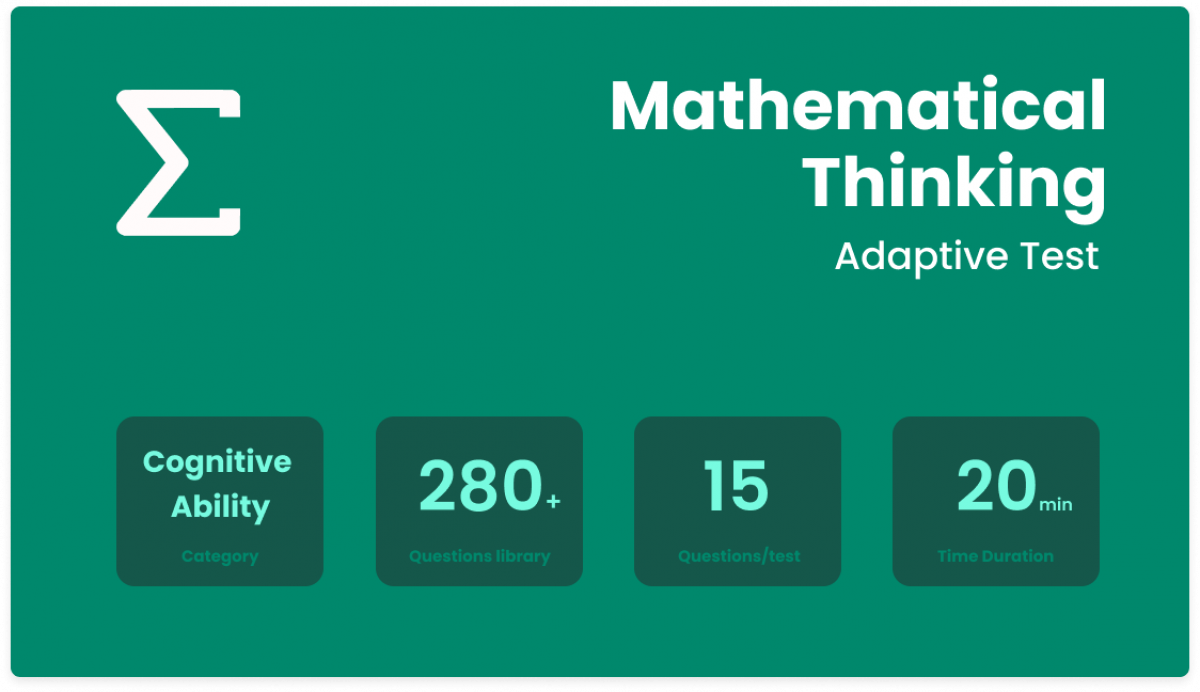Help Desk
Mathematical Thinking

About
The Mathematical Thinking test assesses the candidate’s ability to understand, interpret and analyze quantitative information, solve problems using mathematical models, and apply basic concepts of Algebra, arithmetic, geometry, and statistics.
The test is an adaptive test that varies the difficulty of the questions based on the current performance of the candidate, thereby zeroing in on a fairly definitive measure of the candidate. The result of this section is given in percentiles, relative to the whole test pool population of Merreo.
What does this section measure?
- Problem Solving
- Ability to reason, model, and solve problems with quantitative method
- Ability to reframe verbal problems into equations to solve quantitatively
- Understanding, interpreting, and analyzing quantitative information
Where to use this test?
The ultimate goal of this test is to measure the mathematical problem-solving ability of candidates. So this test is relevant in all places where you expect candidates to be analytically strong.
For example,
- Finance Analyst
- Business Analyst
- Data Analytics
- and most engineering roles
Please avoid using this test for roles that don't demand analytical rigor. Please use our data-driven pre-sets for the best results.
Subjects Covered
- Algebra
- Arithmetic
- Geometry
- Statistics
- Applied math
Arithmetic: Types and properties of integers are covered in this course. Some of these include divisibility, prime numbers, restated numbers, exponents, roots, and odd and even integers.
Algebra: Topics in algebra include operations with exponent values, simplifying algebraic expressions, and solving linear and quadratic equations.
Statistics: topics include basic statistics, such as mean, median, range, Standard distribution, and Normal distribution as well as various interpretations of data in tables and graphs (line graphs, bar graphs, pie charts).
Geometry: Topics in geometry include parallel lines, circles, triangles, and equilaterals. Various types of polygons, congruent and similar three-dimensional figures, coordinate geometry, and the Pythagorean Theorem.
Applied math: Applied math-type questions include application-type problems of one or a combination of the above topics. Some of the additional topics in this section include rates, percentages, ratios, sets, combinations, and rudimentary probability.
Example Questions
Multiple choice question
Each multiple-choice question tends to have 4 or 5 answer choices and one has to choose the best one out of them. There will always be only one correct answer among the choices.
Example question,
If 52/z is a positive integer, how many integer values are possible for z?
A. 5
B. 6
C. 7
D. 8
E. 10
Answer – The factors of 52 are:
• 1 & 52
• 2 & 26
• 4 & 13
Since the negative values cannot be considered for 52/z to be positive, there are 6 factors, so the answer is (B).
Multiple answer question
Each multiple-answer question will have a minimum of 3 choices and a maximum of 10 choices. One has to select all the questions that apply. There will be a minimum of one correct answer and a maximum of all the choices being correct.
Example problem,
(p)^11 (q)^14 (r)^9 > 0. Which of the following statements must be true?
Select all such statements.
pq is negative
pqr is positive
pr is positive
Answer -
pq is negative: for p11q14r9 to be positive, given that q4 will always be positive, it is not necessary for pq to be negative. pq can be negative when either p or q is negative, but among the two, only the q can be negative, as making p negative will make p11q14r9 negative.
pqr is positive: given that q and r must be positive in all cases, and q can be either positive or negative, it is not necessary for pqr to be positive
pr is positive: since p and r must be positive, pr must be positive. This is the only correct choice (Correct)
Numerical entry type question
This type of question must be answered by typing the answers directly in the text box. The answer will be marked correct only if it is precise to the exact decimal figure asked in the question.
Example problem,
In a certain election race, all of the 7,700 votes were cast for either Mr. Daniel or Mr. Lewis. If votes for Mr. Daniel and votes for Mr. Lewis were cast in a 4 to 3 ratio, how many votes were cast for Mr. Daniel?
___________ Votes
Answer - 4400
Daniel got 4 parts of the votes and Lewis got 3 parts of the votes
Total parts = 7
Votes per part = 1100
Votes for Daniel = 4400 (the number must be typed on the box)
Supported by:
